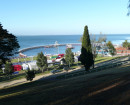GREEN'S CREEK BATTERY
ALPINE NATIONAL PARK AND OFF DARTMOUTH JEEP TRACK DARTMOUTH, TOWONG SHIRE
-
Add to tour
You must log in to do that.
-
Share
-
Shortlist place
You must log in to do that.
- Download report
Statement of Significance
What is significant?
The Greens Creek Gold Battery Site consists of the remains of a 10-head stamping battery, horizontal steam engine, two multi tubular boilers, and various buried and partly buried pieces of machinery. In the vicinity of the battery is a dray track and inclined tramway. The site is on the Register of the National Estate and has recently had major conservation works.
How is it significant?
The Greens Creek Gold Battery Site is of historical and scientific importance to the State of Victoria.
Why is it significant?
The Greens Creek Gold Battery Site is historically and scientifically important as a characteristic and well preserved example of an important form of gold mining. The battery is significant as one of the most intact sites of its kind and age in the State. It was installed in 1884 to crush stone obtained from the Morning Star Mine, which is located on the spur, 500 feet above the battery. Gold mining sites are of crucial importance for the pivotal role they have played since 1851 in the development of Victoria. As well as being a significant producer of Victoria's nineteenth century wealth, with its intensive use of machinery, played an important role in the development of Victorian manufacturing industry. The abandoned mining machinery at the Greens Creek battery site is historically important for its evocation of the adventurousness, hardship, and isolation that was part of mining life in the high country areas of the State.
The Greens Creek Gold Battery Site is archaeologically important for its potential to yield artefacts and evidence which will be able to provide significant information about the technological history of gold mining.
[Source: Victorian Heritage Register]
-
-
GREEN'S CREEK BATTERY - History
Heritage Inventory History of Site:
The Morning Star mine was situated on a ridge 500 ft above the battery site, and about 25 chains (500 m ) to the south-west. A cable-operated counter-balanced tramway ran directly down the hillside conveying ore from mine to battery. A parcel of 400 tons crushed late in 1884 yielded a disappointing 240 oz, and was the only large crushing recorded for the Morning Star mine. A number of other mines in the vicinity sent ore to the Morning Star battery for crushing. The Golden Eagle Reef, half a mile down Greens Creek to the west, was connected to the battery by a track cut along the hillside, along which ore was carried either by horse drays or a horse tram. The battery also crushed for the Clara mine. It is likely that the Morning Star Co. battery crushed more quartz for neighbouring mines than it did from the company's own mine. A year after the battery's completion, there was still insufficient quartz from mines in the locality to keep the plant running at anything like full capacity, and average yields were also beginning to decline. Claims were abandoned as miners drifted away to fields offering better prospects. That Greens Creek never rated highly as a mining locality is evinced by the number of miners there in its heyday: 38 in June 1884, 20 at the end of September, and just seven in mid-1885.
There was a slight revival in 1887, when some further crushings were done for the Clara mine and Morton & party, but the Morning Star mine did not reopen and within a few months the battery was again idle. In 1888, the Saltpetre United GMC called for tenders to remove the Morning Star battery to a site on Saltpetre Creek. It is not known whether the Greens Creek plant was actually sold at this time, but the move obviously never went ahead as planned and in the following year the Saltpetre Co. installed an alternative plant with Cornish Rolls driven by a Pelton wheel.
All the mines on Greens and Larsens creeks had closed down by the early 1890s. In 1905, the Dark River Mining Sub-division was abolished, almost all mining activity on the field having ceased. Churchward says that the Morning Star battery (already idle for 15 years) began to be known, at about that time, as the 'Greens Creek battery'.Heritage Inventory Description
GREEN'S CREEK BATTERY - Heritage Inventory Description
Features are: two boilers, steam engine, stamp battery, pump, foundations, day track and Morning Star Tramway Site.
Heritage Inventory Significance: National Estate/n'The Greens Creek battery site is the only known example of a 19th-century steam-powered quartz crushing plant in Victoria where the three main machinery elements (vis. boilers, steam engine and stamp battery) survive, intact and still standing in situ. In addition, the site contains both the oldest known Victorian-built steam engine and the oldest known Victorian-built multitubular boilers that survive in situ, at the site of their original installation./nThe machinery at Greens Creek provides a good representative example of Victorian gold-mining technology of the late 19th century. The Greens Creek battery is, in addition, the most extensive and intact machinery installation to survive in the State, from the output of a firm that was both Victoria's earliest foundry and one of the State's largest 19th century mining machinery manufacturers and exporters.' (Churchward, p. 17)
Recorded by: Churchward (1991-3) Date Recorded: 1991 Heritage Inventory Key Components: /nBoilers - Two single-drum underfired multitubular boilers. Maker's name plaque cast into front face plate: Langlands Foundry Co. Ltd, Melbourne. Date of manufacture, 1883. /nSteam engine - Single-cylinder horizontal non-condensing (double-acting) stationary steam engine. Manufactured by Langlands Foundry Co. Ltd, Melbourne, 1884 (according to slide provided by Ted Stabb of CNR Wodonga, which shows maker's name plaque cast onto the now-missing steamchest cover)./nStamp battery - 10-head, iron-framed, revolving gravity stamp battery. Maker's plaque cast into side faces of battery frame pillars: Langlands Foundry Co. Ltd, Melbourne, 1882. Mortar boxes have been partially dismantled, and all of the stamps have been removed from and sit upright (in 1991) on the ground behind the boxes. Other loose battery components lying about the site include cast iron lining plates from one mortar box, two sets of mercury troughs and a clutch control mechanism./nBattery pump - Situated below the north end of the battery campshaft is a small double-acting force pump which raised process water for the battery from a well about 3 m to the east into an elevated iron tank. Both suction and delivery pipes are still attached to the pump casing, and a number of other components of the pump are scattered about, including drive pulley, pump pulley, crank, connecting rod, etc./nSteam engine foundations - Shallow depressions beneath the engine bedplate indicate the position of timber foundations./nBattery frame foundations - Clear depressions indicate where battery foundation timbers were positioned./nMortar box foundations - Both mortar blocks are badly charred above ground level, which supports the hypothesis that the battery and engine foundations were destroyed by fire rather than by gradual decay.
-
-
-
-
-
GREENS CREEK BATTERY SITE
 Victorian Heritage Register H1266
Victorian Heritage Register H1266 -
GREEN'S CREEK BATTERY
 Victorian Heritage Inventory
Victorian Heritage Inventory
-
-







